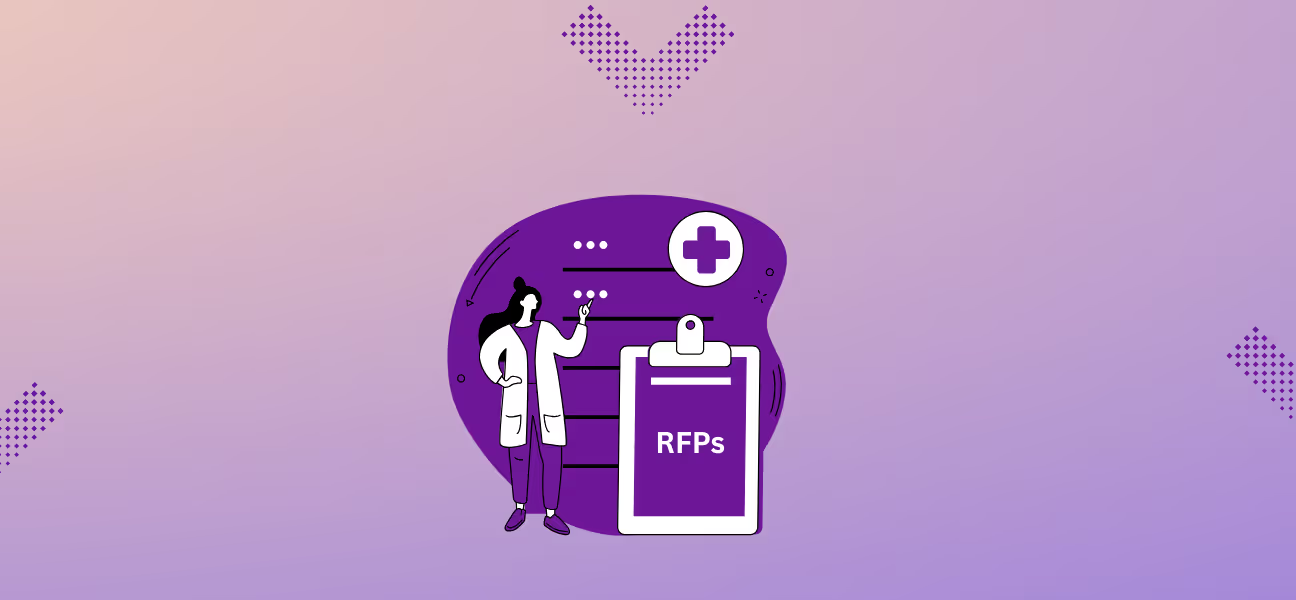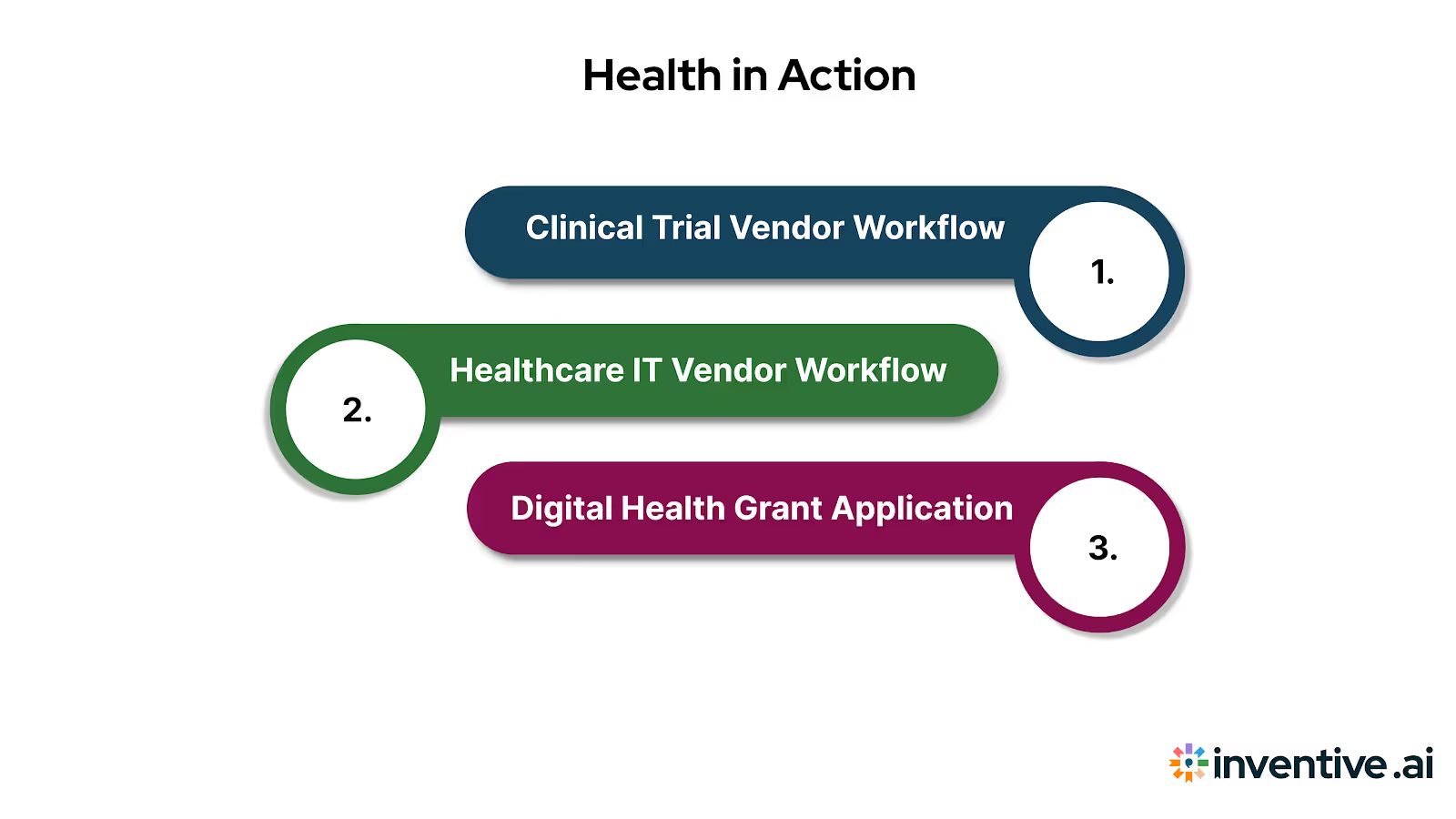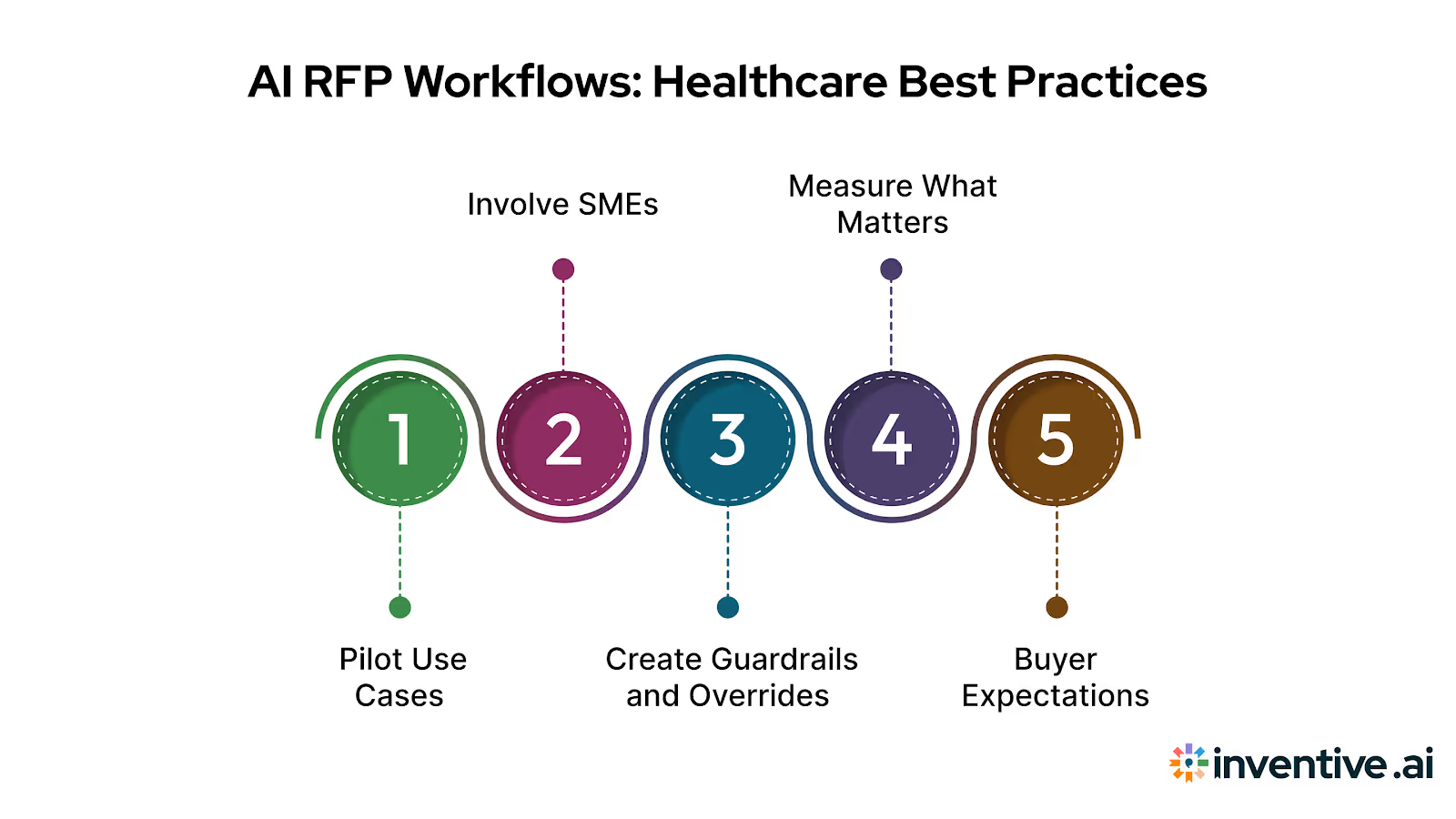Examples of AI Workflow for Healthcare RFPs
Explore real-world examples of healthcare RFP workflow AI in action. Learn how automation improves speed, accuracy, and win rates while overcoming manual proces

Healthcare RFPs are uniquely complex. They are steeped in regulatory obligations, loaded with technical security requirements, and often managed by teams stretched thin across compliance, clinical, and commercial responsibilities. Content reuse is risky without strict version control. And every submission feels like a fresh scramble, no matter how many times you've answered the same question.
These bottlenecks aren’t just frustrating; they delay proposals, create inconsistencies, and can cost deals.
That’s where AI RFP workflows come in. AI agents trained on your approved content can automatically draft answers, flag compliance risks, and tailor responses to each buyer’s language and priorities. According to Salesforce, AI agents can reduce healthcare paperwork by 30%, but the real value lies in improving clarity, speed, and alignment without losing control.
This guide examines real-world examples of how healthcare teams are already utilizing AI agents to expedite responses and meet buyers’ specific priorities. Then we walk through the common challenges organizations face when implementing these workflows and offer practical strategies for rolling out AI workflows that stay compliant and deliver measurable value.
TL;DR
- AI workflows are gaining traction in healthcare RFPs, helping teams generate faster, more relevant, and compliant responses without increasing overhead.
- Manual workflows are still common, but risky, slowing down proposal teams and creating gaps in consistency, compliance, and buyer alignment.
- Best practices for implementation: Start by automating 10–20% of low-risk responses using only SME-approved and previously submitted content.
- Future-ready workflows will involve multi-agent collaboration, autonomous knowledge curation, and AI tools tuned to vertical-specific needs.
What Is an AI Workflow for RFPs?
An AI workflow for RFPs is a structured sequence of automation steps applied across the proposal lifecycle, starting from intake and qualification through response drafting, SME review, compliance validation, and submission formatting. These workflows are rule-based and configurable, designed to guide how each task is completed, routed, and approved.
In healthcare RFPs, where accuracy, regulatory compliance, and SME validation are non-negotiable, AI workflows give teams a consistent and auditable system to manage high-volume RFP activity. Instead of relying on siloed tools and scattered processes, teams can use AI to manage routing logic, enforce internal review paths, and surface the right content at the right time.
Why AI Workflows Matter in Health Care
Manual RFP workflows in healthcare are rarely documented, often improvised, and almost always inefficient. Teams rely on institutional memory, disconnected file versions, and long email threads to coordinate responses. As bid volumes increase, this model breaks down quickly:
- Deadlines are missed due to unclear task ownership.
- Legal and clinical SMEs are looped in too late or overwhelmed with repeated questions.
- Content reuse becomes risky because there’s no system to track what was approved, when, and by whom.
- Compliance checkpoints are handled ad hoc, increasing the chance of regulatory gaps or contradictory language.
AI workflows solve this by replacing informal habits with a repeatable system that mirrors how high-performing teams work at scale. Each workflow can be tailored to your product type, compliance obligations, and internal hierarchy.
Key advantages include:
- Traceability: Every edit, SME input, and compliance tag is logged.
- Modularity: Teams can adjust workflows by RFP type or buyer (e.g., public health vs. private payers).
- Control: Responses are generated from approved sources, not outdated content libraries.
- Collaboration: SME review is integrated into the workflow with minimal back-and-forth.
Whether you're responding to payer RFPs, hospital tenders, or life sciences procurement, AI workflows help you operate at the pace of demand, without sacrificing accuracy or compliance.
Real-World Examples of Healthcare RFP AI Workflows

AI workflows are most valuable when tailored to the specific needs of a vendor’s niche, whether that’s clinical operations, digital infrastructure, or consumer-facing health platforms.
The following examples demonstrate how healthcare organizations are leveraging AI-driven workflows to minimize delays, enhance compliance, and streamline their proposal operations.
Example 1: Clinical Trial Vendor Workflow
Scenario: Mid-sized Clinical Research Organization (CRO) bidding for decentralized clinical trial (DCT) contracts from global pharmaceutical sponsors.
Challenge: Frequent last-minute RFPs with sponsor-specific requirements, complex SME input (medical writing, safety), and strict adherence to FDA and GCP standards.
Workflow:
- RFP Intake: AI parses protocol requirements and aligns with historical proposals.
- Regulatory Mapping: AI identifies sections requiring terminology compliant with FDA (Food and Drug Administration) regulations and GCP (Good Clinical Practice) standards.
- Smart Prefill: Standard sections like patient safety, monitoring plans, and recruitment timelines are autofilled from past responses.
- Compliance Review: Medical and regulatory SMEs (Subject Matter Experts) are looped in via workflow triggers.
- Submission: A complete, compliance-aligned response is ready in under 48 hours.
Outcome: Reduced compliance risks and turnaround time for complex, multi-region bids.
Example 2: Healthcare IT Vendor Workflow
Scenario: EHR and interoperability solution vendor responding to state hospital RFPs for patient record integration and HL7/FHIR compliance.
Challenge: Navigating dense technical requirements, demonstrating interoperability proof, and coordinating inputs from legal, engineering, and clinical advisory teams.
Workflow:
- Triage: AI classifies questions into security, interoperability, and training sections.
- Routing: Security items go directly to the CISO; integration questions to the tech lead.
- Metadata Matching: AI inserts standardized HL7 (Health Level 7) and FHIR (Fast Healthcare Interoperability Resources) tags to ensure terminology matches hospital IT specs.
- Final Assembly: Consistent messaging across compliance, technical, and commercial sections.
Result: Cut manual triage time by 80%, improved response clarity, and increased shortlist conversion rates.
Example 3: Digital Health Grant Application Workflow
Scenario: Mental health startup applying for public health innovation grants and NHS digital pilot funding.
Challenge: Limited grant writing capacity, need to align with population health goals and NHS digital architecture, and unclear expectations from different funders.
Workflow:
- Grant Parsing: AI dissects funding priorities and matches them with startup initiatives.
- Outcome Modeling: AI drafts an early ROI (Return on Investment) projection with cost-benefit estimates tied to grant objectives.
- SME Injection: Medical director reviews clinical justification; finance lead reviews budget assumptions.
- Narrative Building: AI assembles a compelling story across all sections, backed by internal case studies.
Result: Grant proposal time reduced by 60%, improved alignment with funding priorities, and a higher resubmission success rate.
These examples illustrate how AI workflows can be tailored to real-world business contexts. Across each scenario, the same pattern emerges: AI brings structure, precision, and speed to what were previously fragmented, time-consuming manual processes.
But how do these AI-driven workflows actually stack up against traditional methods still used by many response teams?
Let’s break it down.
How AI Workflows Compare to Traditional RFP Response Processes
AI workflows address the core inefficiencies of manual RFP processes, slow drafting, scattered collaboration, and inconsistent quality. The table below shows where automation delivers the most meaningful improvements.
Common Challenges When Implementing AI RFP Workflows in Healthcare

AI workflows bring speed and consistency to the RFP process, but adopting them in healthcare environments isn’t frictionless. Strict compliance standards, legacy content systems, and cross-functional coordination gaps can all limit early success. Understanding these challenges helps teams roll out AI intentionally, without compromising quality or regulatory obligations.
Compliance and Regulatory Hesitation
Healthcare organizations are highly regulated. Any use of AI that seems to “freely generate” responses raises red flags with legal and compliance teams. Without pre-approved content sources or clear intervention boundaries, workflows can stall due to uncertainty around review obligations.
SME Pushback or Workflow Fatigue
Subject Matter Experts (SMEs) are often skeptical of automation. If early AI drafts are inconsistent or too generic, SMEs may feel they’re rewriting content rather than reviewing it. Poorly introduced workflows can add noise instead of reducing workload.
Training Data Limitations
AI tools are only as good as the content behind them. If knowledge bases are unstructured, outdated, or full of unvetted drafts, the system may surface irrelevant or non-compliant answers. This leads to rework, delays, and eroded trust in the AI’s value.
Misalignment with Submission Requirements
Many RFPs come with strict formatting, word limits, or portal-specific instructions. AI-generated content can miss these nuances unless workflows are designed to flag and adapt to buyer preferences. Manual restructuring late in the process undermines speed gains.
Low Early Adoption or Over-Reliance
Two extremes can limit success: teams that don’t trust the AI enough to use it, and teams that rely on it too early in high-risk scenarios. In both cases, lack of a phased rollout leads to poor results and organizational resistance.
These challenges don’t rule out AI; they highlight the need for a structured rollout. The next section outlines proven best practices to help healthcare teams build workflows that scale safely and effectively.
Also Read: Guide to RFP Automation in Healthcare with AI
A Deeper Dive on Data Security & HIPAA
AI tools can dramatically speed up and improve the accuracy of RFP responses in healthcare, but handling sensitive patient or organizational data requires careful attention. Key considerations include:
- AI Capabilities: Advanced AI can analyze historical RFPs, generate tailored responses, and identify relevant content across vast datasets, improving efficiency and reducing human error.
- HIPAA Compliance: AI platforms must adhere to HIPAA standards, ensuring that protected health information (PHI) is processed securely throughout the workflow.
- Data Handling Risks: Organizations should be aware that feeding AI tools sensitive information can create exposure risks if platforms lack strong security controls or proper contractual safeguards.
- Security Measures: Look for end-to-end encryption, role-based access, audit trails, and secure cloud infrastructure. Data minimization or anonymization features can further reduce risk when AI tools process historical RFPs.
- Balanced Approach: Leverage AI for its efficiency and insight while maintaining strict governance over what data is shared. Only provide necessary, non-identifiable data when possible to limit compliance exposure.
By combining AI efficiency with robust security practices, healthcare teams can accelerate RFP workflows without compromising sensitive information
5 Best Practices for Implementing AI RFP Workflows in Healthcare

Adopting AI for RFP response is not just a technology decision; it’s a process transformation. According to McKinsey, unlike simpler gen AI architectures, AI agents can produce high-quality content, reducing review cycle times by 20 to 60 percent. However, success depends on a thoughtful rollout, clear content boundaries, and strong alignment between SMEs and compliance.
Below are tested best practices for healthcare teams implementing AI workflows for the first time.
1. Start Small: Pilot Use Cases
Don’t begin with full-scale automation. Identify a set of high-volume, low-risk question types, typically 10–20, that are safe to automate. Common starting points include general company info, security policy excerpts, and non-critical product descriptions.
This builds early trust in AI-generated outputs while minimizing risk.
2. Involve SMEs and Legal from Day 1
AI workflows only work if the underlying content is reliable and accurate. Train your AI knowledge base using curated, SME-reviewed materials, such as past wins, approved policy documents, and regulatory submissions.
In parallel, involve compliance and legal teams early to define clear AI boundaries: which sections can be auto-filled, where human review is mandatory, and what formatting rules must be followed.
3. Create Guardrails and Overrides
Establish structured rules for how workflows handle escalation and compliance:
- SME Overrides: Auto-flag complex or sensitive questions for manual review.
- Regulatory Tagging: Ensure responses related to HIPAA, FDA, or HL7 standards are tagged and routed correctly.
- Formatting Consistency: Define how AI should structure answers to meet submission requirements, such as character limits or citation formats.
4. Measure What Matters
Track real metrics to monitor adoption and performance:
- Time to First Draft: How quickly can AI generate a usable first version?
- SME Revision Rate: How often are automated answers edited by experts?
- Compliance Hold-Ups: Where do workflows slow down due to regulatory reviews?
These indicators help identify bottlenecks, measure ROI, and refine automation scope over time.
5. Align Automation with Buyer Expectations
AI-generated responses must still feel human and aligned with the buyer’s tone and values. Utilize your AI workflows to support, rather than replace, the nuances of persuasive and compliant writing.
Regularly review how your workflows perform against client feedback and submission scores.
What’s Next: Future Trends in AI RFP Automation
AI is no longer novel; it's the foundation. The next wave of transformation is being driven by agentic AI: systems that don’t just generate content, but actively coordinate, reason, and adapt across workflows. For healthcare RFP teams, this unlocks new opportunities to pre-qualify bids faster, reduce revision loops, and respond with greater strategic precision.
Here are the trends shaping the future of RFP automation:
Multi-Agent Collaboration
Rather than relying on a single AI model to handle every task, multi-agent systems assign specialized roles to different AI agents; one might analyze compliance risk, another could handle tone alignment, while a third optimizes formatting and structure. These agents interact autonomously, debate decisions, and escalate edge cases to human experts when needed.
For RFP teams, this means fewer errors, faster resolution of complex prompts, and a workflow that mirrors real-world team collaboration, only faster and more scalable.
Integration with EHR, Compliance, and CRM Systems
Next-gen workflows will pull structured data directly from source-of-truth platforms like Electronic Health Records (EHR), GRC tools, and CRMs, eliminating manual copy-paste steps and ensuring every claim or figure is audit-ready and policy-aligned.
Pre-Submission Scoring and Win Prediction
Machine learning models trained on past RFP outcomes will predict response quality and fit before submission. This helps teams prioritize high-probability bids and course-correct weak sections before it’s too late.
Multi-Stakeholder Collaboration Layers
AI will facilitate real-time collaboration among SMEs, compliance, sales, and legal through intelligent routing, feedback prioritization, and conversational revision interfaces. This improves alignment without long email threads or version chaos.
Privacy-First AI Architectures
Especially in healthcare, the future will favor AI tools that offer on-premise deployment, zero-retention policies, and granular control over data access and usage. Vendors that meet these standards will earn more trust and wider adoption.
How Inventive AI Powers the Next Generation of RFP Workflows
Inventive AI’s specialized agents are engineered to give your RFP responses more than just a speed boost; they give you a strategic edge. From shaping competitive positioning to drafting highly tailored answers, each agent contributes to a workflow built for repeatable, high-quality performance.
Strategic Agent Collaboration, Built In
- Brainstorming Agent: Helps your team shape win themes, identify deal-specific differentiators, and align early on messaging, so your first draft isn’t just fast, it’s strategically sound.
- Competitor Research Agent: Surfaces how rivals are positioning and pricing based on public documents, enabling you to respond with sharper messaging and avoid falling into price-only competition.
- Customer Research Agent: Analyzes buyer websites, policies, and content to mirror their tone and priorities, helping you build credibility.
Core Platform Capabilities

- AI RFP Agent: Drafts complete responses in minutes using your internal knowledge base, past wins, and SME-reviewed material, so your team spends less time starting from scratch and more time refining for impact.
- Contextual Responses: Inventive AI’s Context Engine combines buyer research and deal details to produce responses tailored to each opportunity, improving win rates by avoiding generic content.
- Smart Knowledge Hub: Integrates with Google Drive, Notion, SharePoint, and more to create a single, up-to-date source of truth, reducing time spent searching for the “latest” version of approved content.
- AI Content Management: Continuously flags outdated, conflicting, or duplicated material before submission, ensuring accuracy without adding review cycles.
- Slack and CRM Integrations: Keeps proposal and sales teams aligned in real time, directly inside the tools they already use, so no platform switching, no communication gaps.
- 10× Faster Drafting: Delivers high-quality responses up to 10× faster, freeing up SMEs and writers to focus on high-value opportunities instead of routine answers.
Inventive AI’s AI RFP Agent transforms how you respond, turning every RFP into a repeatable, data-driven win strategy instead of a one-off effort. Book a demo today.
Final Thoughts
Healthcare RFPs demand accuracy, speed, and confidence in every submission. Manual workflows make it hard to sustain. Agent-based automation introduces structure, reduces last-minute errors, and gives your team time to focus on strategy, not formatting.
With a clear, repeatable system in place, your proposals don’t just go out faster, they land stronger.
Inventive AI helps you operationalize speed, consistency, and relevance at scale.
Get a live walkthrough tailored to your team.
Book a Demo and See how your next submission could be 10× faster with zero trade-offs.
FAQs on AI-Driven RFP Workflows in Healthcare RFPs
1. Is AI safe to use for security questionnaires and healthcare RFPs?
Yes, if implemented correctly. The best tools let you control what AI can access and how it responds. Inventive AI, for instance, only uses approved content and includes SME override options to ensure the right content.
2. What’s the difference between an AI assistant and an AI agent in RFP workflows?
AI assistants support users passively (e.g., suggesting text), while AI agents take on specific roles like drafting, research, or compliance tracking. Agents operate with goals and autonomy, making them more effective for structured workflows.
3. How long does it take to implement an AI RFP workflow?
Most teams can go live within 2–4 weeks if they start with a focused pilot. Larger deployments (integrated with CRMs, knowledge hubs, etc.) may take longer depending on complexity and internal approvals.
4. What types of RFP questions are ideal for AI automation?
Begin with high-volume, low-risk questions, such as company policies, certifications, and product overviews. These are consistent across bids and easy to govern through your knowledge base.
5. Can AI really reduce submission time without compromising quality?
Yes. When trained on the right content and paired with SME checkpoints, AI can cut drafting time by 90% while maintaining consistency and accuracy across proposals.

